I-J-K
(or icon) |
the use of a well-known symbol or icon; a means to analyze the themes and various styles in a film | |
| generally refers to the picture that is the result of the photographic process | ||
| a specialized, big-screen film format about ten times larger than the traditional cinema format (35mm) and three times larger than the standard 70 mm widescreen format; debuted in Osaka Japan at the 1970 Exposition; IMAX films, often short documentaries, 'educational,' travelogue or nature films, are shot and projected on 15 perforation/70mm gauge film - "15/70", the largest film format in existence, which produces incredible high-definition sharpness in films projected on up to eight-story high screens in theatres equipped with advanced digital surround-sound systems; IMAX projection onto a domed screen is called Omnimax |
Examples: Catch the Sun (1973), Volcano (1973), To Fly (1976), Living Planet (1979), Hail Columbia (1982), Behold Hawaii (1982), The Dream is Alive (1985), and many more. |
|
| refers to filming in the exact order required for the final product, thereby eliminating the post-production editing stage; a fast, albeit unprofessional way to produce a film, often employed by student or amateur film-makers; requires advanced planning to tell the desired story in order; aka in-camera effects, such as double-exposures, split-screen shots, rear-screen and front-projection process shots, etc. | ||
| a term for an entire film or a subset of shots that are all finished shooting; also denotes when a director has the take that he wanted | ||
(indie and independent films) |
small independent, low-budget companies, mini-majors, or entities for financing, producing, and distributing films (i.e., Miramax, New Line Cinema, Polygram) working outside of the system or a major Hollywood studio; however, an indie may lose its independent status when its grows large and powerful; also refers to a movie, director, distributor or producer (sometimes unconventional) not associated with or produced by a major Hollywood film studio; often with groundbreaking subject matter designed for sophisticated audiences, and not necessarily produced with commercial success as the goal, unlike mainstream films |
 Example: California-based Miramax, although the leader in the independent film movement in the early 1990s, has become so powerful and successful that it has lost most of its independent studio status; indie films include Jim Jarmusch’s Stranger Than Paradise (1984), and Kevin Smith's Clerks (1994); the cable TV Independent Film Channel showcases indie films; see 50 Greatest Independent Films Example: California-based Miramax, although the leader in the independent film movement in the early 1990s, has become so powerful and successful that it has lost most of its independent studio status; indie films include Jim Jarmusch’s Stranger Than Paradise (1984), and Kevin Smith's Clerks (1994); the cable TV Independent Film Channel showcases indie films; see 50 Greatest Independent Films |
| another name for the film or entertainment industry; also referred to as the biz, show business, show-biz, Hollywood, or the town. | ||
| a young, teenaged female actress often in an important or lead role in a film; usually portrays an innocent, sometimes naive, and attractive character; also refers to an actress sometimes known as a starlet; the male counterpart is known as a juvenile. | 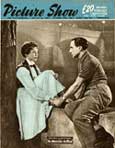 Example: young Leslie Caron as Lise in An American in Paris (1951) in contrast to Nina Foch as womanly-wise Milo Example: young Leslie Caron as Lise in An American in Paris (1951) in contrast to Nina Foch as womanly-wise Milo |
|
| slang term meaning to 'sign' a contract | ||
| a shot that occurs in the middle of a larger scene or shot, usually a close-up of some detail or object, that draws audience attention, provides specific information, or simply breaks up the film sequence (e.g., a quivering hand above a gun holster in a Western, a wristwatch face, a letter, a doorbell button, a newspaper headline, a calendar, a clock face, a key inserted into a car's ignition); an insert shot is filmed from a different angle and/or focal length from the master shot and is different from a cutaway shot (that includes action not covered in the master shot); also known as cut-in. |
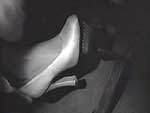 Example: an insert shot during the car crash scene with an hysterical Lana Turner, in The Bad and the Beautiful (1954) Example: an insert shot during the car crash scene with an hysterical Lana Turner, in The Bad and the Beautiful (1954) |
|
| in a film, an obscure, show-biz related joke that is understood (or realized) only by those who know the reference (outside the context of the film) | Example: Finding Nemo (2003) names its great white shark Bruce - the same name given to the mechanical shark on the set of Steven Spielberg’s Jaws (1975); in A Clockwork Orange (1971), the soundtrack to Kubrick's earlier film 2001: A Space Odyssey (1968) is very visible in the record store scene | |
| usually refers to a series of shots, consisting of two simultaneous events, that are alternated together to create suspense; intercutting can also consist of shots of two people involved in a telephone conversation |  Example: Speed (1994) - the bomb, the bus' speedometer, other action, all intercut Example: Speed (1994) - the bomb, the bus' speedometer, other action, all intercut |
|
| a brief, intervening film scene or sequence, not specifically tied to the plot, that appears within a film. |  Example: Harpo Marx's musical interlude performances of his harp in the Marx Brothers films. Example: Harpo Marx's musical interlude performances of his harp in the Marx Brothers films. |
|
| a break in the middle of a film, normally in a feature-length film of three hours or more (although rare in current-day films); originally, intermissions served as a 'stretch-restroom' opportunity, or provided time for the projectionist to change reels; they often were accompanied by a medley of the film's score - or a song score for musicals; the strategy of film theaters nowadays is to show a film as many times as possible during the day | Examples: West Side Story (1961), Lawrence of Arabia (1962), My Fair Lady (1964), Doctor Zhivago (1965) | |
| refers to a person or object that moves into the picture frame without the camera moving; in live-action stage plays, this refers to a character entering the stage | ||
(or irising) |
an earlier cinematographic technique or wipe effect, in the form of an expanding or diminishing circle (known as iris-out or iris-in), in which a part of the screen is blacked out so that only a portion of the image can be seen by the viewer; usually the lens aperture is circular or oval shaped and is often expanded or contracted as the film rolls, often as a transition from one scene to the next; this particular type of camera movement is also known as iris wipe, or circle-in/circle-out, similar to the opening or closing of the human eye's iris; also refers to the adjustable opening (or diaphragm) in the lens that allows light to pass through - the measurement for the iris opening is f-stop |
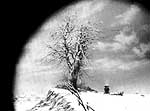 Example: Commonly used in silent films, such as The Birth of a Nation (1915), or here in Welles' The Magnificent Ambersons (1942) as Eugene's horseless carriage drives away Example: Commonly used in silent films, such as The Birth of a Nation (1915), or here in Welles' The Magnificent Ambersons (1942) as Eugene's horseless carriage drives away |
| refers to the tendency in show business to prioritize individuals (stars, writers, would-be celebrities, or up-and-comers) as 'hot' or 'watchable' - highlighting those who have suddenly 'burst onto the scene' and are either notable and bankable; those who had some transient success or 'brush with greatness, but then were demoted from the list are called forgotten, has-beens, shooting stars, or flashes in the pan (after "fifteen minutes of fame" - an Andy Warhol expression); aka "A" List | 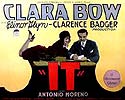 Example: "It" originally referred to the sex appeal of 20s flapper star and "It Girl" Clara Bow, popularized in the film It (1927); a modern day "It" List individual is (was) Monica Lewinsky. Example: "It" originally referred to the sex appeal of 20s flapper star and "It Girl" Clara Bow, popularized in the film It (1927); a modern day "It" List individual is (was) Monica Lewinsky. |
|
| see L-cut (below); aka split edit | ||
| a filmed musical (drama, or animation, etc.) that uses pre-existing popular songs (usually from a variety of artistic sources) as its song score; the songs are often re-imagined with different song styles; aka karaoke musical | Examples: Singin' in the Rain (1952), Thoroughly Modern Millie (1964), Everyone Says I Love You (1996), A Knight's Tale (2001), Moulin Rouge! (2001), Happy Feet (2006) | |
| an abrupt, disorienting transitional device in the middle of a continuous shot in which the action is noticeably advanced in time and/or cut between two similar scenes, either done accidentally (a technical flaw or the result of bad editing) or purposefully (to create discontinuity for artistic effect); also contrast with an ellipsis and match cut | 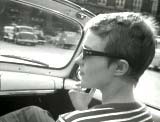 Example: in The Thirty-Nine Steps (1935) the screams of the chambermaid/landlady at the sight of a murdered corpse are replaced by the piercing screeches from a train whistle as a train emerges from a tunnel, in Don't Look Now (1973), the director Nicolas Roeg cuts from the wife's scream on seeing her dead daughter to the drill her husband is using in his work on the church in Venice - a sound match and cut; in Deconstructing Harry (1997), jump cuts indicate the protagonist's fractured, distracted mind; also, the car ride with the camera behind Jean Seberg in Godard's New Wave film Breathless (1960, Fr.) (pictured) Example: in The Thirty-Nine Steps (1935) the screams of the chambermaid/landlady at the sight of a murdered corpse are replaced by the piercing screeches from a train whistle as a train emerges from a tunnel, in Don't Look Now (1973), the director Nicolas Roeg cuts from the wife's scream on seeing her dead daughter to the drill her husband is using in his work on the church in Venice - a sound match and cut; in Deconstructing Harry (1997), jump cuts indicate the protagonist's fractured, distracted mind; also, the car ride with the camera behind Jean Seberg in Godard's New Wave film Breathless (1960, Fr.) (pictured) |
|
| the role of a young, teenaged male character; the female counterpart is known as an ingenue. | ||
| in a film, the contiguous positioning of either two images, characters, objects, or two scenes in sequence, in order to compare and contrast them, or establish a relationship between them; see also sequence, symmetry, and composition. |  Example: the famous 'baptism scene' - the murders of the heads of various crime families juxtaposed with the baptism ceremony for Michael's god child at the conclusion of The Godfather (1972); the parallel imagery in the "Making Christmas" sequence of The Nightmare Before Christmas (1993) Example: the famous 'baptism scene' - the murders of the heads of various crime families juxtaposed with the baptism ceremony for Michael's god child at the conclusion of The Godfather (1972); the parallel imagery in the "Making Christmas" sequence of The Nightmare Before Christmas (1993) |
|
| the main or primary light on a subject, often angled and off-center (or from above) that selectively illuminates various prominent features of the image to produce depth, shadows, etc.; high-key lighting(with everything evenly and brightly lit, with a minimum of shadows) is termed realistic (and often used in musicals and comedies), while low-key lighting (with less illumination, more shadows, and many grayish, dark areas) is termed expressionistic (and often used in film noir); three-point lightinguses: (1) a fill (or filler) light - an auxiliary light to soften shadows and areas not covered by the key light, (2) a back light behind to add depth to a subject, and (3) a bright key light |
 Example: low-key lighting in the film-noirish Touch of Evil (1958). Example: low-key lighting in the film-noirish Touch of Evil (1958). |
|
| a term denoting the start of production or principal photography | ||
| a type of powerful carbon-arc lamp that produces an intense light, often used in film-making; also used for promotional purposes at film premieres | ||
| another term for an awards show; see Academy Awards | ||
źródło:www.filmsite.org